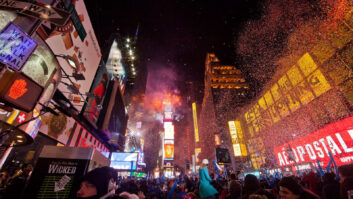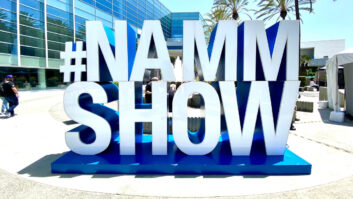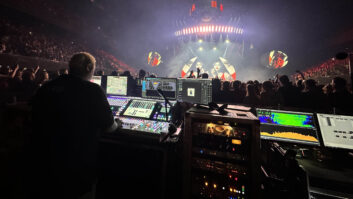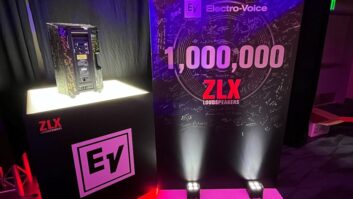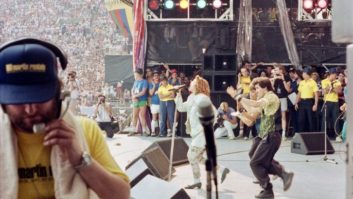ATLANTIC CITY NJ—Don’t let the name fool you: Foreigner is at home everywhere. A hard-touring band since starting in the mid-1970s, the veteran rock act still performs all over the world, led by guitarist/songwriter Mick Jones, as it delivers an unrelenting barrage of international hits like—to name only a few—“Juke Box Hero,” “Urgent, “Head Games,” “Cold As Ice,” “Hot Blooded” and “Waiting For a Girl Like you.”
When Foreigner played The Borgata in Atlantic City, NJ, the band’s show was heard through Bose RoomMatch Progressive Directivity Arrays. That’s just some of the band’s backlog of big singles, however; as Foreigner’s FOH engineer, Brian Simon, points out, “Mick’s written so many songs, you could do a five-hour show and not repeat anything. As it is, we play different set lists in different countries, because in Germany, for instance, they love certain songs that Americans don’t even know about. That makes it fun to go to South America and other places, because you get to mix some songs that you haven’t heard in a few months.”

Regardless of the hits being played, consistency is the name of the game, not only in terms of performance but also the audio quality provided for both the audience and band itself. The group travels light, picking up local production at every stop using rider-requested gear for both Simon’s FOH position and monitor engineer Lorenzo Banda at stageside. While the engineers have favorite gear they know well, they’re not above trying something new—as was the case during a recent two-night stand at the 1,000-seat Music Box theater inside the Borgata Hotel Casino and Spa in Atlantic City, NJ, where Foreigner was heard through Bose RoomMatch Progressive Directivity Arrays.
On-hand to ensure that everything went smoothly was Rob Kosman, events and applications specialist from the Professional Systems Division of Bose. “The coverage that we’re getting is very consistent, all the way front-to-back as well as side-by-side,” he said, walking around the venue. “We were listening to it yesterday and the guys described it as sounding the same in every position throughout the room—which is great; that’s what the system was designed to do.”
The uniformity, Kosman said, was due to how the system had been applied to the venue: “With Room- Match, we have array modules in a variety of vertical and horizontal angles, because ultimately the goal is to have the narrowest coverage for the farthest throw—so that it hits exactly where you want it—and the widest coverage for the near throw. Since you’re essentially balancing the sound pressure level by varying the coverage, you end up with a consistent level across the room.”
As a result, the stage left and right hangs of six modules each sported RM7005s on top—throwing 70×5 degrees— followed by RM9005s (90×5 degrees), three RM12010s (120×10 degrees) and a RM12020 (120×20 degrees); together, they provided 60 degrees of vertical coverage. Rounding out the system were three RMS218 subs per side and a quartet of RMU208 front-fills on the stage lip; everything was run off Bose PowerMatch amplifiers employing Dante networking to pass audio between stage left and right amplifier locations, where four PM8500s powered each array.
While it was Foreigner’s first time using RoomMatch arrays, the band had certainly played “Feels Like The First Time” through Bose products before, having long used L1 Model II portable systems with B2 bass modules and T1 ToneMatch engines for intimate acoustic VIP performances.
If the PA was new to the band, however, there was plenty of familiar gear on-hand, too, such as the Avid Venue Profile at the FOH position. “I find it to be really user-friendly,” said Simon. “It does all the things I want to do and the footprint can’t beat; as long as you have the right plug-in package, you can play anything from clubs to stadiums and it does a great job.”
Plug-ins present are usually from Waves, he reported: “I use the C6 Multiband Compressor, and that alone saves the day—I use it on my main left-right bus, my vocals, my background vocal groups. Then I have the Renaissance Axx plug-in for my acoustic guitars to make them pop out. Waves Doubler for my vocals—I use a single one for Kelly [Hansen, lead vocals] and I use the four voices for background vocals. There’s the API EQ on a few things, and the L2 Ultra-maximizer, which keeps the mix in the right dynamic range. A lot of places in Europe, we have to stay at a 98 dB limit, so I use it to brick-wall myself, but it doesn’t pump or breathe, so it’s really seamless. I love it.”
Helping meet those SPL limits, the seven-man band has a relatively quiet stage, despite the array of guitars on-hand. “Our guitar cabinets are in Randall isolation boxes,” said Simon. “I’ve got three guitar players all playing the same type of material on three Les Pauls, so to get separation, I use different combinations of mics. On Mr. Jones, I use a 56 on one of his cabinets and a 57 on another, while with Bruce Watson, our other guitar player, I use two 57s. Then on Tom Gimbel, I use a Heil and a Neumann.”
Capturing the drum kit is a job largely accomplished with a selection of Shure mics, with a Beta 91A in the kick, SM57s above and below the snare, and SM81s and KSM32s on various cymbals, as well as a Audix D2 and D4 on high and low toms and a Sennheiser e 602 outside the kick. Vocals are captured with Earthworks SR40V condenser mics and capsules that the band helped develop over the course of a year’s worth of roadwork.
In all, Simon works with 56 inputs, striving each night to recreate the intricate mixes found on albums like the Mutt Lange-produced 4 while still honoring the live performance onstage. “I do my best to keep the integrity of the songs as people know them, because that’s why they come to see the band,” he said. “I focus on getting that fullrange sound, an overall mix. Some of the older stuff from the Seventies isn’t as dynamic as something from the mid-Eighties. If you mix something like ‘Starrider’ off the first record, it can’t sound as big and bold as ‘I Want To Know What Love Is.’ Luckily, the set list has a great flow, so I don’t have to go from 1976 to 1986 and then back again; it has a natural progression and dynamic that makes it pretty smooth as far as the audience is concerned.”
And concern for the audience is key to Simon’s approach to mixing, not just for Foreigner but every act he’s mixed over the years—a list that includes Counting Crows, Night Ranger and Little River Band. “The biggest thing is you have to be a fan of what you’re mixing,” he shared. “I don’t think you give an audience what they want or do a band justice otherwise, because you’re not paying attention to the nuances, the little things that people expect to hear. If you don’t give that to them, then you’re letting the audience down. I truly believe that I’m the advocate for the audience—FOH guys are there to ask them to buy a ticket next year.”
Bose Professional Systems Division
pro.bose.com
